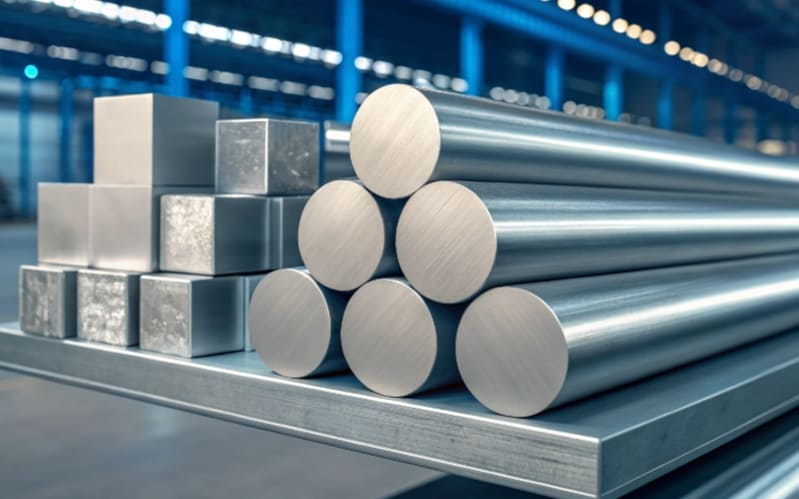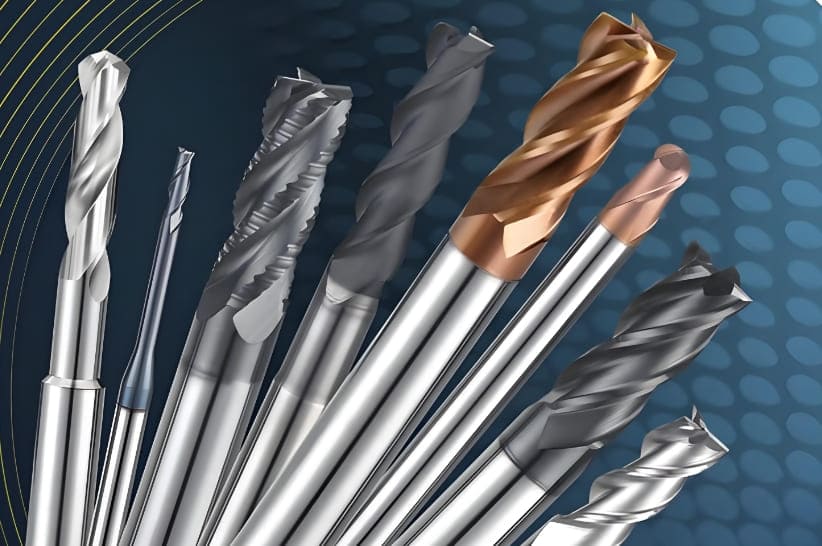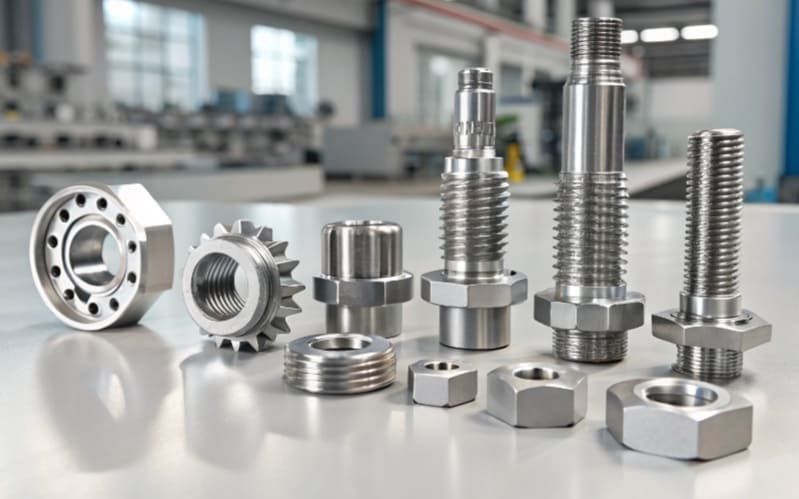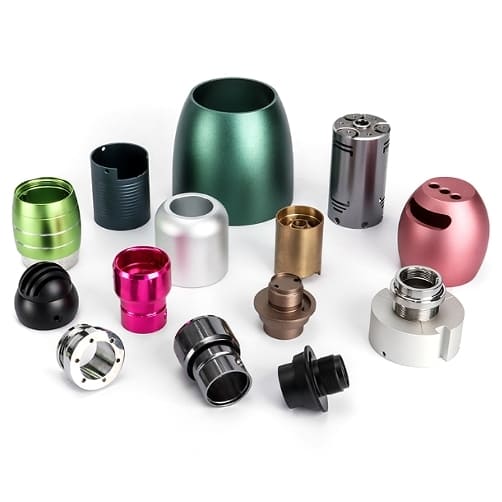Titanium is highly valued in industries for its strength, lightness, and corrosion resistance. But when it comes to CNC machining, titanium is famous for being difficult to work with. Why is it so challenging? Let’s explore.
CNC machining of titanium involves precise techniques to handle its hardness, heat resistance, and reactivity, ensuring high-quality outcomes for various industries.

Titanium is extraordinary, but its properties make it one of the toughest materials to machine. Let’s break it down, starting with its characteristics.
What Are the Characteristics of Titanium?
Titanium has transformed modern engineering by addressing critical challenges in high-performance industries. Materials often fail under extreme conditions, but titanium’s exceptional properties fill this gap, providing strength, durability, and resistance where it’s needed most.
Titanium is lightweight, Biocompatible1, corrosion-resistant, and maintains strength at high temperatures, making it ideal for demanding applications.

- Lightweight: Titanium’s density of about 4.5 g/cm³ makes it nearly half as dense as steel, while maintaining comparable strength. This property is crucial for aerospace, automotive, and other industries focused on weight reduction.
- Corrosion Resistance: A natural oxide layer forms on titanium, protecting it from rust and chemical damage. This resistance extends to seawater and harsh chemical environments, making it essential for marine and medical uses.
- Strength-to-weight ratio2: Titanium offers an exceptional balance of durability and lightness, making it indispensable in applications like aircraft frames, prosthetics, and performance sports equipment.
- High-Temperature Stability: Unlike many materials, titanium retains its strength and integrity at elevated temperatures, ensuring reliable performance in jet engines, turbines, and other heat-intensive environments.
- Biocompatibility: Titanium is non-toxic and compatible with the human body, which is why it is a top choice for surgical implants and prosthetics.
These properties make titanium highly versatile but also introduce unique challenges during machining.
What Is Grade in Titanium?
When designing precision components, choosing the right material can be overwhelming. Titanium grades simplify this process by offering different blends of purity and alloys to meet specific performance requirements. This adaptability has made titanium indispensable.
Titanium grades are classifications based on purity or alloy composition, determining strength, corrosion resistance, and machinability3.
All Titanium Grades and Their Characteristics:
Commercially Pure (CP) Titanium Grades
These grades consist of nearly pure titanium with varying levels of oxygen content, which affect their strength and ductility. They are highly corrosion-resistant and easy to weld.
-
Grade 1:
Purity: The softest and most ductile grade.
Properties: Excellent corrosion resistance, high formability, and low strength.
Applications: Chemical processing, marine equipment, medical industries, and architectural structures. -
Grade 2:
Purity: A balance between strength and corrosion resistance.
Properties: Moderate strength, excellent corrosion resistance, and good weldability.
Applications: Aerospace parts, heat exchangers, piping systems, and desalination plants. -
Grade 3:
Purity: Slightly stronger than Grade 2 but less ductile.
Properties: High strength, good corrosion resistance.
Applications: Chemical processing equipment and industrial parts. -
Grade 4:
Purity: The strongest of the CP grades.
Properties: High strength and excellent corrosion resistance, but less formable than lower CP grades.
Applications: Medical implants, aerospace, and marine components.
Titanium Alloys (Grades 5-38)
These grades are alloyed with elements like aluminum, vanadium, molybdenum, and iron to enhance their strength, heat resistance, and specific properties.
-
Grade 5 (Ti6Al4V):
Composition: 6% Aluminum, 4% Vanadium.
Properties: High strength, excellent heat resistance, and lightweight.
Applications: Aerospace, medical implants, and military applications. -
Grade 6 (Ti5Al2.5Sn):
Composition: 5% Aluminum, 2.5% Tin.
Properties: Superior oxidation resistance and moderate strength.
Applications: Jet engines, airframes, and high-temperature environments. -
Grade 7 (Ti0.2Pd):
Composition: 0.2% Palladium.
Properties: Exceptional corrosion resistance, especially in acidic environments.
Applications: Chemical processing, desalination plants, and marine industries. -
Grade 9 (Ti3Al2.5V):
Composition: 3% Aluminum, 2.5% Vanadium.
Properties: High strength-to-weight ratio and corrosion resistance.
Applications: Sports equipment, automotive, and heat exchangers. -
Grade 12 (Ti0.3Mo0.8Ni):
Composition: 0.3% Molybdenum, 0.8% Nickel.
Properties: Excellent corrosion resistance in reducing and oxidizing environments.
Applications: Power generation and chemical processing. -
Grade 23 (Ti6Al4V ELI):
Composition: Similar to Grade 5 but with extra-low interstitials (ELI) for improved biocompatibility.
Properties: High strength, excellent fracture toughness, and biocompatibility.
Applications: Medical implants, surgical tools, and aerospace. -
Beta Alloys (e.g., Grades 19, 21, 38):
Composition: Alloyed with elements like molybdenum, niobium, or zirconium.
Properties: Higher strength, improved machinability, and better cold formability than other grades.
Applications: Automotive, aerospace, and sports industries.
Selecting the Right Grade
Choosing the appropriate titanium grade depends on the specific requirements of the application, including strength, corrosion resistance, machinability, and biocompatibility. Each grade offers unique advantages tailored to demanding environments across industries.
What Are the Industrial Applications of Titanium?
Industries that rely on cutting-edge materials often struggle to balance performance and reliability. Titanium has emerged as a solution, delivering unmatched capabilities in extreme environments, from outer space to inside the human body.
Titanium is used in aerospace, medical, automotive, and marine industries for its lightweight strength and corrosion resistance.

Industrial Applications of Titanium:
- Aerospace: Aircraft structures, jet engines, and landing gear benefit from titanium’s lightweight and heat-resistant properties, enhancing fuel efficiency and performance.
- Medical: Titanium’s biocompatibility makes it ideal for implants such as hip joints, dental implants, and pacemaker casings, ensuring long-term compatibility with the human body.
- Automotive: High-performance vehicles use titanium for exhaust systems, engine components, and connecting rods, reducing weight while enhancing strength.
- Marine: Titanium is employed in submarines, offshore platforms, and seawater pipelines due to its unmatched corrosion resistance.
- Energy: It is critical in the production of components for power plants, especially in high-temperature or corrosive environments like nuclear reactors and desalination plants.
These applications highlight why precision machining of titanium is crucial for advancing technology in demanding sectors.
Can Titanium Be CNC Machined?
The need for precision in advanced manufacturing often pushes the limits of materials and technology. Titanium, though challenging, has become a critical material in CNC machining, enabling the production of high-performance components.
Yes, titanium can be CNC machined, but it requires specialized tools, parameters, and techniques for optimal results.

Key Requirements for Machining Titanium:
- Specialized Tools: Carbide tools with wear-resistant coatings like TiAlN are essential for managing heat and tool wear.
- Optimized Parameters: Slow cutting speeds, proper feed rates, and cooling systems are vital to avoid excessive heat buildup and premature tool failure.
- Cutting Fluids: High-quality coolants ensure heat dissipation and reduce the reactivity of titanium with the cutting tools.
- Rigidity and Stability: Robust machine setups reduce vibrations and improve the quality of cuts on titanium’s tough surface.
CNC machining has evolved to meet these demands, making it possible to harness titanium’s properties for advanced industrial applications.
Why Is Machining of Titanium Difficult?
Machining titanium is a task that requires skill and careful preparation. Its unique properties, while beneficial in finished products, create significant difficulties in the machining process. These challenges can be frustrating, especially without the right tools or techniques.
Machining titanium is difficult because it generates excessive heat, causes rapid tool wear, and can harden during cutting, making it harder to shape as machining progresses.
Let me walk you through the main reasons titanium is so tough to machine and how its characteristics influence the process.
Titanium’s low thermal conductivity4: A hidden challenge
Titanium’s low thermal conductivity is a core reason why machining it is tricky. Unlike aluminum or steel, titanium does not efficiently transfer heat away from the cutting zone. Instead, most of the heat remains concentrated at the tool’s edge, causing overheating. This not only accelerates tool wear but also increases the risk of material distortion, particularly in thin-walled parts.
Here’s how this compares to other materials:
| Material | Thermal Conductivity (W/m·K) | Heat Dissipation Efficiency |
|---|---|---|
| Aluminum | 237 | Excellent |
| Steel (mild) | 43 | Moderate |
| Titanium | 21.9 | Poor |
Work hardening: The self-strengthening paradox
When titanium is cut, it tends to harden at the cutting site. This phenomenon, known as work hardening, makes subsequent cuts more difficult. The hardened layer increases tool pressure, accelerates wear, and requires higher precision to maintain surface quality. It also reduces machining speeds, as cutting through hardened titanium demands slower, more deliberate passes.
Reactivity with cutting tools
Another factor is titanium’s chemical reactivity at high temperatures. As the cutting zone heats up, titanium can bond with the tool material. This reaction creates a build-up edge (BUE) that dulls the tool and reduces cutting efficiency. Carbide tools with coatings like aluminum titanium nitride (AlTiN) are commonly used to mitigate this issue, but even these can wear down quickly under extreme conditions.
Vibration and chatter during machining
Titanium’s low modulus of elasticity means it is less rigid than many metals. This flexibility can lead to vibration and chatter during machining, especially when cutting large or unsupported parts. These vibrations not only reduce machining accuracy but can also cause fatigue in tools and machines over time.
Addressing these challenges requires careful planning, precise parameters, and advanced tooling.
What Tooling Is Required for Machining Titanium?
Machining titanium demands specialized tools that can handle its unique properties without sacrificing precision or efficiency. Without the right tooling, machining titanium can lead to excessive tool wear, poor surface finishes, and reduced productivity.
The best tooling for machining titanium includes carbide tools with heat-resistant coatings, sharp cutting edges, and high-speed machining compatibility.

Let’s explore what makes tooling for titanium machining so critical and how to choose the right ones.
Why are carbide tools essential for titanium?
Carbide tools are the go-to choice for titanium machining due to their hardness and heat resistance. Unlike steel tools, carbide can withstand the high temperatures generated during titanium cutting without losing its edge. This is crucial since titanium’s low thermal conductivity directs heat back into the tool.
Key benefits of carbide tools:
- High heat resistance: Prevents thermal degradation of the cutting edge.
- Superior hardness: Maintains sharpness for extended periods.
- Reduced reactivity: Coated carbide tools reduce titanium’s tendency to bond with the tool.
Common coatings for carbide tools include:
| Coating Type | Benefits |
|---|---|
| AlTiN (Aluminum Titanium Nitride) | High heat resistance, ideal for dry machining. |
| TiAlN (Titanium Aluminum Nitride) | Reduces heat build-up, prevents tool wear. |
| DLC (Diamond-Like Carbon)5 | Reduces friction and material adhesion. |
Why sharp cutting edges are critical?
Sharp cutting edges are essential for machining titanium because they minimize cutting forces. A dull tool can exacerbate work hardening, making the machining process even more difficult. Tools with a high positive rake angle are particularly effective because they reduce the cutting resistance and improve chip evacuation.
How does tool geometry impact titanium machining?
Tool geometry plays a critical role in ensuring smooth machining of titanium. Here are a few design features to look for:
- Positive rake angles: Reduce cutting force and heat generation.
- Special chip breakers: Enhance chip evacuation, preventing chips from clogging and overheating the workpiece.
- Reinforced tool cores: Improve stability and reduce the risk of tool breakage.
Role of coolant delivery systems
A proper coolant delivery system is as important as the tooling itself. High-pressure coolant systems help dissipate heat and prevent material adhesion to the cutting edge. Coolants like water-soluble oils or synthetic fluids are commonly used to reduce friction and improve surface finish.
Example of recommended tool configurations
| Tool Type | Material | Application |
|---|---|---|
| End Mills | Carbide with AlTiN | Slotting and profiling in titanium alloys. |
| Inserts | Coated Carbide | Turning applications for aerospace parts. |
| Drills | Solid Carbide with DLC | Deep hole drilling in titanium components. |
What Are the Parameters for Machining Titanium?
The margin for error in machining titanium is razor-thin. Without the right parameters, excessive heat and rapid tool wear can derail production, turning an efficient process into a costly operation.
Optimal feed rates, low cutting speeds, and proper cooling are key parameters for machining titanium efficiently and safely.
Key Machining Parameters:
- Cutting Speed: Keep cutting speeds between 30-70 meters per minute (m/min) to prevent overheating and tool wear. Titanium’s low thermal conductivity means excess heat needs to be minimized.
- Feed Rate: A moderate feed rate (around 0.1-0.3 mm per tooth) ensures steady material removal without overloading the cutting tool.
- Depth of Cut: Shallow cuts are preferred, usually 1-3 mm, to maintain tool longevity and surface quality.
- Cooling and Lubrication: Use high-pressure coolant to effectively remove heat and chips, reducing thermal damage and tool wear.
- Tool Path Strategy: Employ constant chip load6 and adaptive machining strategies to evenly distribute wear on the cutting tool.
Fine-tuning these parameters improves productivity while reducing tool failure and material damage, ensuring high-quality machining results.
What RPM Is Needed for Milling Titanium?
Milling titanium requires precise speed and feed settings to balance heat management, tool wear, and material removal. Using improper RPM can lead to overheating, poor surface quality, and excessive tool wear.
The recommended RPM for milling titanium depends on the tool diameter, cutting speed, and material grade, typically ranging from 1,000 to 4,000 RPM for most applications.
Setting the right RPM is crucial to maintaining productivity while preserving tool life and workpiece integrity.
Spindle Speed Considerations:
- Material Properties: The strength and elasticity of titanium require slower speeds to minimize frictional heat.
- Tool Diameter: Larger tools need slower spindle speeds to prevent chatter and excessive cutting force.
- Coated Tools: Tools coated with TiAlN or similar materials can tolerate slightly higher RPMs while dissipating heat more effectively.
Optimizing spindle speed ensures a stable cutting process, extends tool life, and reduces the risk of part deformation or overheating.
What Are the Challenges of Titanium Machining?
Titanium is a remarkable material with unmatched strength-to-weight ratios and corrosion resistance. But machining titanium presents significant challenges. These obstacles can affect productivity, costs, and the precision of final parts.
Titanium machining is challenging due to its poor thermal conductivity, high strength, and work-hardening properties, which lead to tool wear, overheating, and machining difficulties.

Understanding why titanium is so difficult to machine requires a closer look at the material properties and how they impact the machining process.
Detailed Challenges:
- Low Thermal Conductivity: Titanium retains heat at the cutting zone, causing thermal stress on tools and the workpiece.
- High Strength and Toughness: Its resistance to deformation increases cutting forces, leading to quicker tool wear.
- Elasticity: Titanium’s elasticity can cause chatter and deflection, making precision machining harder to achieve.
- Built-Up Edge (BUE): Titanium tends to bond with the cutting tool, reducing cutting efficiency and leading to tool failure.
These challenges demand advanced techniques, precise tooling, and well-calibrated machine setups to ensure successful machining outcomes.
What Is the Most Machinable Titanium?
Titanium is known for its strength and durability, but not all grades are created equal when it comes to machinability. Some titanium alloys are easier to machine than others, making them more suitable for specific applications.
The most machinable titanium is commercially pure titanium (Grade 2) and certain alpha-beta alloys like Ti-6Al-4V, due to their balanced strength, corrosion resistance, and moderate machining challenges.
Let’s explore why these grades stand out and what makes them easier to work with.
Why is Grade 2 titanium more machinable?
Grade 2 titanium, often referred to as commercially pure titanium, is relatively soft compared to other titanium alloys. It has high corrosion resistance and good weldability, making it ideal for chemical processing, marine applications, and medical equipment.
Key features of Grade 2 titanium:
- Lower strength: Easier to cut and shape compared to higher-grade alloys.
- High ductility: Reduces the risk of cracking or deformation during machining.
- Good thermal conductivity: Better heat dissipation than more complex alloys.
These properties make Grade 2 a popular choice when both machinability and corrosion resistance are essential.
| Property | Grade 2 (CP Titanium) | Ti-6Al-4V |
|---|---|---|
| Tensile Strength (MPa) | 345 | 950 |
| Ductility (% elongation) | 20-25% | 10-15% |
| Hardness (Rockwell C) | ~25 | ~36 |
Why is Ti-6Al-4V widely used despite being harder to machine?
Ti-6Al-4V, an alpha-beta alloy, is one of the most popular titanium grades. It offers an excellent balance between strength, weight, and corrosion resistance, making it the industry standard in aerospace, medical implants, and industrial components.
Machinability challenges:
- Higher hardness: Ti-6Al-4V is significantly harder than Grade 2 titanium.
- Low thermal conductivity: Increases heat buildup at the cutting edge.
- Prone to work hardening: Requires precise machining techniques to avoid hardening the surface.
Despite these challenges, Ti-6Al-4V remains a preferred choice due to its mechanical properties and versatility. Advanced tooling and machining strategies are often employed to mitigate its machining difficulties.
What about other titanium grades?
Other titanium grades, such as Grades 1, 5, and 23, are used in specialized applications. Each has unique characteristics that make them suitable for specific industries and machining requirements.
| Titanium Grade | Primary Application | Machinability |
|---|---|---|
| Grade 1 | Chemical processing, marine hardware | Easiest to machine, softest. |
| Grade 2 | Chemical processing, architecture | Good machinability. |
| Grade 5 (Ti-6Al-4V) | Aerospace, medical implants | Harder to machine, widely used. |
| Grade 23 | Medical implants | Hard to machine, high precision. |
How do machinists choose the right titanium grade?
When selecting a titanium grade, machinists consider factors like strength requirements, corrosion resistance, and machining difficulty. For example:
- If machinability is the top priority: Grade 2 is the ideal choice due to its lower strength and easier cutting properties.
- For applications demanding high strength and durability: Ti-6Al-4V (Grade 5) is the industry standard, though it requires advanced machining techniques.
Practical machining tips for different titanium grades
For Grade 2:
Use high-speed steel (HSS) tools or coated carbide tools for efficiency.
Moderate cutting speeds and aggressive coolant application reduce heat buildup.
For Ti-6Al-4V:
Stick to carbide tools with coatings like AlTiN or TiAlN.
Employ lower cutting speeds, high feed rates, and consistent cooling.
For Grades 5 and 23:
Use advanced CNC machines with precise controls.
Prioritize tool rigidity and stable cutting conditions to minimize vibrations.
Understanding the properties and machinability of titanium grades helps machinists optimize their processes.
Is Titanium Expensive to Machine?
Titanium’s unique properties make it a valuable material, but these same characteristics can drive up machining costs. From tool wear to slower machining speeds, the expenses quickly add up, making titanium one of the costlier materials to machine.
Yes, titanium is expensive to machine due to high tool wear, specialized equipment requirements, and slower machining processes, all of which increase production time and costs.
The cost factor doesn’t just stem from the material itself but from the entire machining process required to turn raw titanium into a finished product.
Factors Contributing to Cost:
- Tool Wear: High tool replacement rates significantly increase operational expenses.
- Machining Time: Slower speeds and feeds result in longer production cycles.
- Cooling Systems: Specialized coolants and delivery systems add to operational costs.
- Machine Tool Requirements: Titanium machining requires rigid and stable CNC machines capable of handling high cutting forces.
Despite the expense, titanium’s superior properties often justify the investment for high-performance applications.
Is Grade 5 Titanium Hard to Machine?
Grade 5 titanium, also known as Ti-6Al-4V, is a popular titanium alloy used in aerospace, medical, and automotive industries. Its impressive strength-to-weight ratio and corrosion resistance make it ideal for high-performance applications. However, these same properties also create machining challenges.
Yes, Grade 5 titanium is hard to machine due to its high strength, low thermal conductivity, and tendency to work-harden, which can lead to tool wear, overheating, and difficulty maintaining precision.
Key Challenges of Grade 5:
- High Strength: Its tensile strength of over 900 MPa makes cutting forces much higher than those required for pure titanium grades.
- Heat Generation: Grade 5 generates more heat during cutting, increasing tool wear and the risk of thermal damage.
- Applications: Its superior strength and resistance make it indispensable for aerospace, medical implants, and automotive components, where durability and performance are critical.
To machine Grade 5 effectively, manufacturers rely on advanced CNC systems, coated carbide tools, and optimized parameters.
Is Titanium Harder to Machine Than Steel?
Titanium and steel are two widely used metals in industries ranging from aerospace to construction. While both are essential materials, their machining requirements differ significantly due to their unique properties.
Yes, titanium is harder to machine than steel because of its low thermal conductivity, high strength, elasticity, and tendency to work-harden, making it more challenging to cut and more taxing on tools.
Understanding the differences between titanium and steel machining is crucial for selecting the right material for specific applications and optimizing production processes.
Comparing Titanium and Steel:
- Thermal Conductivity: Steel dissipates heat more efficiently than titanium, reducing the risk of overheating.
- Toughness: While high-strength steel grades are hard to machine, titanium’s combination of strength and elasticity introduces chatter and deflection issues.
- Tool Wear: Titanium causes higher wear rates due to its reactivity and the heat generated during cutting.
Understanding these differences allows manufacturers to adapt their machining strategies, leveraging titanium’s advantages while mitigating its challenges.
Conclusion
Titanium is a remarkable material, offering unmatched strength, lightness, and corrosion resistance. However, its unique properties make CNC machining a challenging yet rewarding process. With the right tools, parameters, and expertise, titanium opens the door to endless possibilities in industries that demand high performance.
-
Biocompatibility is essential to understand as it directly impacts the safety and effectiveness of materials used in medical devices, implants, and other applications interacting with living tissue. ↩
-
Knowing the strength-to-weight ratio helps industries select materials that balance durability with efficiency, which is critical in applications like aerospace and automotive manufacturing. ↩
-
Machinability is crucial because it determines the feasibility and cost of manufacturing components, particularly when working with tough materials like titanium. ↩
-
Thermal conductivity affects heat dissipation during machining. Understanding this property helps in managing tool wear, avoiding part distortion, and improving machining efficiency. ↩
-
DLC coatings are important for reducing friction and enhancing tool life, especially in high-heat and high-precision machining scenarios. ↩
-
Constant chip load is significant because it ensures consistent cutting forces, extending tool life and improving the surface finish of the machined part. ↩
